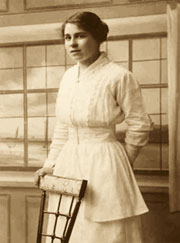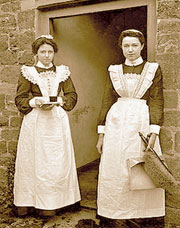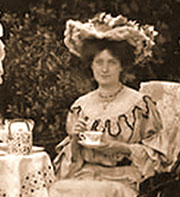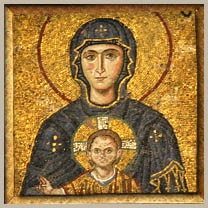Here's a page dedicated to this famous mosaic in the apse sem-dome of the great cathedral church of old Byzantium. It dates from the original redecoration of the church after iconoclasm ended.
Cutting Bread and Cold Meat, Service of Cheese
UTENSILS NEEDED
Hard-wood board for bread.
" " " " meat.
Thin, sharp knives for meat.
" " knife, or a saw knife, for bread.
Steel fork for holding meat.
Cut the bread for breakfast, luncheon, and supper in thin slices of uniform thickness; three eighths of an inch is the most satisfactory thickness.
Bread for dinner is cut in thick slices; if the loaf be square the slices are divided into two or four pieces. The pieces should be about three by four inches. Slices cut from a French loaf are not divided. The crust is not removed. Bread for sandwiches is cut as for breakfast. For picnic basket or box for traveling, fanciful shapes are not desirable. As novelties in the service of bread we give ribbon bread and cassava cakes.
RIBBON BREAD
(To serve with oysters, salads, or at five o'clock tea or a card party)
Cut Boston brown bread and white bread into slices of uniform thickness. Spread a slice of white bread thick with butter, and press upon it a slice of brown bread also spread with butter. Spread this with butter, and upon it press a slice of buttered white bread. Use in all five or six slices of bread, having the colors alternate. Trim off the crusts, and slice as ordinary bread.
TOASTED CASSAVA BREAD
Spread the cakes light with butter on both sides, then toast as bread. When delicately browned, serve at once in the folds of a hot napkin. These cakes are particularly appropriate for afternoon tea. They sell for about twenty-five cents per box. A box contains two dozen cakes. At the close of a dinner or luncheon, cassava cakes may be served with cheese. Prepare as above, or spread with butter and grated cheese, and set into a hot oven long enough to melt the cheese.
CUTTING COLD MEAT
Cut cold meat across the grain. Make the slices no thicker than is needed to hold the fibres together. Retain a narrow edge of fat on slices of roast beef, baked or boiled ham, and baked fresh pork. All cold joints and fowls are sliced in the same manner as they would be carved if hot.
SERVICE OF CHEESE
Cheese is served before the sweet dish with a salad, or sometimes with crackers immediately following the sweet dish. To prepare an Edam or pineapple cheese for the table, cut off the top neatly, retain this to fit tightly back in place when set aside, to keep the cheese from drying. Wrap the cheese in a napkin, or at least set it into a folded napkin that comes up around the cheese. The outside of a cheese, especially in warm weather, is liable to be oily, but when partially covered with a napkin one may help himself to cheese without soiling the fingers. At the first service of a whole cheese, the silver scoop cannot be set into the cheese; lay it on the tray in front of the cheese with the handle towards the hand of the one served. American dairy cheese is usually cut in small, uniform pieces and served upon a plate covered with a lace paper. Camembert and Philadelphia cream cheeses are served whole or cut in small pieces on a plate covered with lace paper.
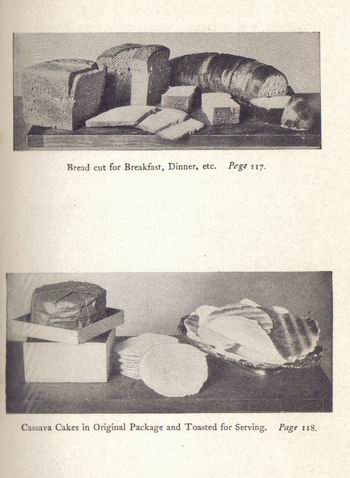

CREAM CHEESE WITH BAR-LE-D0C CURRANTS, FLOWER FASHION
To serve Eight
(Serve with crackers or cassava bread as a last course at luncheon)
Dispose crisp heart leaves of lettuce, carefully cleansed and dried, in a circle on a serving dish, to simulate the calyx of a flower. Press one or two cream cheeses through a ricer onto the inner and stem ends of the lettuce, forming a wreath of the cheese, and fill the centre with red Bar-le-Duc currants. If desired, half a cup of cream, beaten solid with one fourth a teaspoon-ful of salt, may be mixed with the cheese before it is pressed through the ricer.
